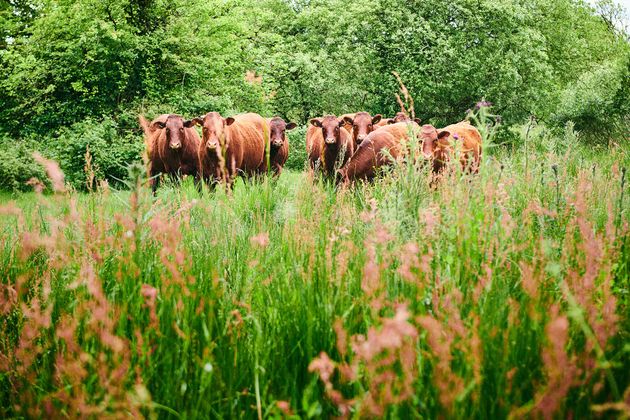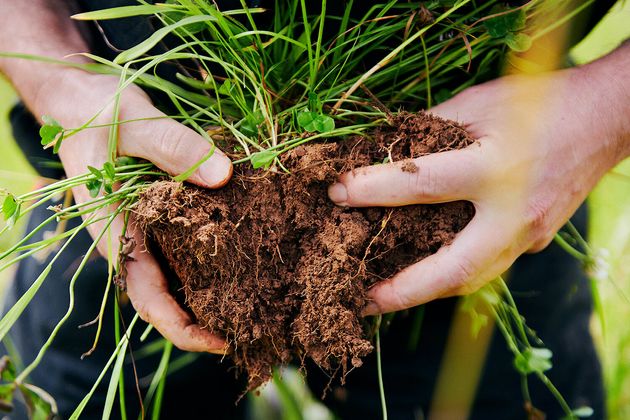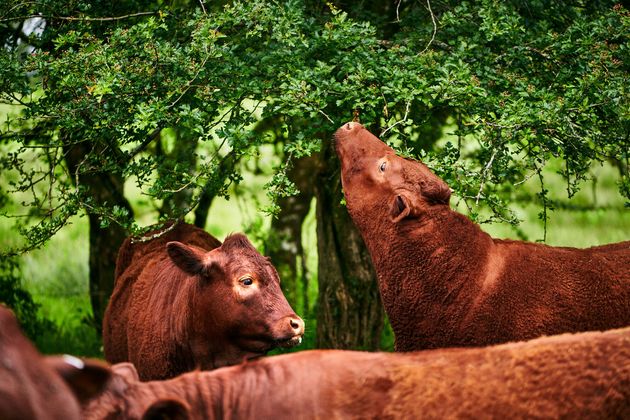 |
| There is at least one acre of land per cow at this farm that uses regenerative production in North Devon, UK. SCOTT GRUMMETT |
We've been told our consumption of meat is destroying the environment. But the real issue is meat production, not meat itself. Regenerative farming could be the answer.
Meat has had a rough few years. Since a shocking 2006 report found that livestock are a major contributor to climate change, there has been a nationwide ― if not global ― movement to eat less meat.
But many experts say that the war on meat is missing the point. There is an extensive body of research suggesting that livestock should not shoulder blame for the climate crisis. In fact, these experts would argue that grazing animals are a crucial part of the solution.
“The current methods of meat production are absolutely unacceptable from an environmental and animal welfare standpoint, but that doesn’t logically lead us to the conclusion that we should get rid of meat,” said Nicolette Hahn Niman, an environmental-lawyer-turned-cattle-rancher and author of “Defending Beef.” “The conversation tends to miss this basic point: It’s not whether or not we have animals, it’s how they’re managed.”
Niman’s book explains in great scientific detail how, through proper management systems, livestock have the potential to positively impact ― even reverse ― the effects of climate change.
The principles in her book are part of a movement known as regenerative agriculture, which is gaining traction worldwide. With studies finding that cutting emissions alone is not enough to mitigate climate change, we need to work toward restoring past damage and minimizing excess carbon in the atmosphere. Regenerative agriculture claims that the solution doesn’t lie in new technology or mass machinery. It may be right in front of us: livestock.
But it means moving livestock from feedlots― which account for 80% of the meat produced today ― back to pastured grasslands, mimicking the natural ecosystems that existed long before industrial agriculture took hold.
 |
| Tom Tolputt holds soil from his regenerative farm. This dense and vibrant soil shows deep root systems that come from integrating livestock onto the field. SCOTT |
How livestock could help us decrease our carbon footprint
Through a process called carbon sequestration, grazing animals help pull excess carbon from the atmosphere and bury it into the soil.
“One of the major roles of plants is to pull carbon out of the atmosphere and they do this best when they are actively growing,” said Allen Williams, a livestock management consultant and leading expert in regenerative agriculture. “When a plant is bitten off by a grazing or browsing animal, it speeds up its rate of photosynthesis to grow back the part that was broken off. Every time it does that, it increases carbon sequestration.”
Williams runs the regenerative agriculture program at Joyce Farms, a large-scale pastured meat operation in Winston-Salem, North Carolina. “We’ve documented on our farms that through regenerative grazing, we can sequester anywhere between 5 and 7.4 tons of carbon per acre annually,” Williams told HuffPost.
When you start farming regeneratively, you rely a lot less on external inputs, such as fertilizers, chemicals and feeds. ... Who is going to promote a style of farming that they can’t make a profit off of?Tom Tolputt, a regenerative farmer and farm consultant
That’s a promising number. While it doesn’t necessarily match the 40 gigatons (that’s 40 billion tons) of greenhouse gases we emit each year, applying these principles to the 12 billion acres of agricultural land worldwide would certainly make a dent. Theoretically, we could sequester anywhere from 60 to 90 gigatons of carbon per year.
The success at Joyce Farms is echoed by a long list of scientific studies, including a comprehensive 2013 report by the United Nations Food and Agriculture Organization ― the same organization that released the infamous 2006 report ― which found that carbon sequestration from pastured livestock could offset agricultural emissions by 1.5 gigatons per year. If applied on a large scale, this could make our agricultural sector carbon neutral within a matter of years.
The practice is so promising when it comes to mitigating climate change that the Department of Agriculture recently initiated pilot programs to incentivize farmers who increase the level of carbon in their soils.
And about livestock’s problematic methane production? A 2019 study funded by General Mills found that White Oak Pastures, a pastured livestock operation in southwest Georgia, offset over 100% of its grass-fed beef emissions, meaning they sequestered more greenhouse gases — including methane — than they produced.
Integrating livestock into a regenerative agriculture system also offsets emissions from industrial agriculture practices ― such as using synthetic fertilizers, agrochemicals, and gasoline-powered farm equipment, which account for 45% of agriculture’s greenhouse gas emissions ― by replacing them with the natural benefits of grazing.
Through grazing, animals are constantly restoring and replenishing the land, pushing nutrition into the soil through trampling leaves and naturally fertilizing the soil with their manure. This reduces the need for some fossil fueled machinery, like tills and plows, and completely eliminates the need for synthetic fertilizers, which in addition to emitting methane and nitrogen in the field, require fossil fuels to be produced. Rebuilding natural ecosystems also enacts some controls on pests and weeds, eliminating the need for agrochemicals.
If this is such a great system, why aren’t all farmers doing it?
Tom Tolputt, a regenerative farmer and farm consultant in England’s Southwest region,says there’s one primary reason regenerative agriculture practices struggle to take hold on a large scale: Farming regeneratively means disrupting a highly profitable supply chain.
 |
| A breed of cow called Red Rubies, which has been bred over centuries to survive on the marshy wetlands... SCOTT GRUMMETT. A breed of cow called Red Rubies, which has been bred over centuries to survive on the marshy wetlands in Devon. |
“When you start farming regeneratively, you rely a lot less on external inputs, such as fertilizers, chemicals and feeds, which means there’s fewer external livings to be made from the companies that are manufacturing these things,” Tolputt said. “Who is going to promote a style of farming that they can’t make a profit off of?”
Many of the industrial agriculture practices used today became subsidized by the U.S. government during the Great Depression and World War II, in an attempt to feed a hugely hungry world. “Suddenly, farming on a large scale became hugely important,” Tolputt told HuffPost. “Anything that had a positive effect on yield was embraced,” which included repurposing war chemicals as nitrogen fertilizers and pesticides.
These days, those subsidies, fertilizers and pesticides come with enormous profit for chemical manufacturers and commercial farms, which have used their incredible lobbying power to exclude small family farms from subsidies, thus raising land values.
“It’s a lot easier to farm with chemicals, and it especially was when we had no idea about the detrimental effects on the soil,” Tolputt told HuffPost. “It was incredibly efficient with the knowledge they had at the time. It’s only now that carbon burn, soil loss and soil health are being fully understood.” These once-innovative farming tools are destroying our ecosystems.
We have this huge planetary food system enhanced by synthetic fertilizers and chemicals, but there are ways to balance that out now, and that’s through raising animals in balance with the ecosystem’s restoration. Nothing else can do what a cow or sheep or buffalo can do. Jack Algiere, farm director at Stone Barns for Food and Agriculture
Large-scale industrial farming has led to a vast decrease in soil organic matter, the nutritious topsoil that feeds plants and grasses and supports deep root systems that trap rainwater in addition to carbon.
Integrating livestock into a farming system can rebuild soil organic matter at a rate of 0.1% per year. While that may sound small, a mere 0.1% increase in organic matter increases the soil’s ability to hold water by 2,000 gallons per acre, while sequestering an additional 3.6 metric tons of atmospheric carbon.
“We’re using these animals for the sake of restoration,” said Jack Algiere, farm director at Stone Barns Center for Food and Agriculture, which practices regenerative production. “We have this huge planetary food system enhanced by synthetic fertilizers and chemicals, but there are ways to balance that out now, and that’s through raising animals in balance with the ecosystem’s restoration. Nothing else can do what a cow or sheep or buffalo can do. That process is unique to grass and ruminant animals and their symbiotic relationship with the land.”
And it’s not just cows that regenerate the soil: Pastured pigs and poultry help “disturb” the soil (in a good way) while foraging, and further feed the pasture with their manure.
What does this mean for consumers?
We don’t necessarily need to stop eating meat, but we do need to seek out high-quality meat from regenerative producers.
While “regenerative” doesn’t yet exist on food labels, look for terms like “pasture-raised,” “pastured,” “grass-fed,” and “free-range,” Williams said. Each of these labels implies a different grazing method or time on pasture, but they’re all a better choice than conventional, grain-fed meat. “If it doesn’t say grass-fed on the label, it’s not,” Williams told HuffPost. “That’s a guarantee that it was raised in a feedlot.”
Our best bet is to educate ourselves about where our meat (and all our food) is coming from and the practices used to raise it.
“Don’t be afraid to ask questions,” Williams told HuffPost, adding that consumers have an incredible effect on the market. “Go to the grocery store and ask for products that are regeneratively produced. Go to restaurants and demand grass-fed meat and dairy. You’ll be amazed at how quickly those businesses will respond.”
Grass-fed meat may be more expensive: At most grocery stores, grass-fed beef can be $2 to $4 more per pound than conventional beef. This beef is often imported from Australia or New Zealand, increasing the price. Buying from your local butcher or farmer’s market might help lower costs. The more we support a system of small-scale farmers, the more we increase demand. Plus, grass-fed beef is significantly more nutritious, giving it more bang for its buck.
And while avoiding factory-farmed meat is a good thing, it’s important to remember that vegan meat substitutes can carry a similarly hefty carbon footprint. Genetically modified soy, the primary ingredient in the Impossible Burger, is made from the same industrial monoculture crop grown for animal feed.
Page: Huff Post Brasil


















0 comentários
Agradecemos seu comentário! Volte sempre :)